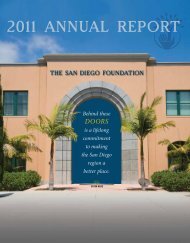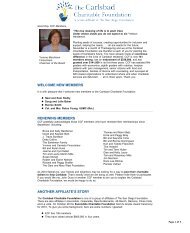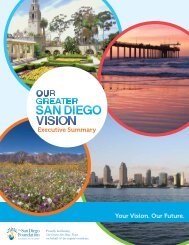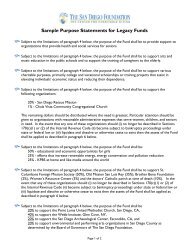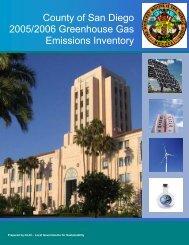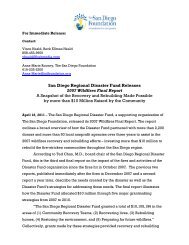Focus 2050 Study - The San Diego Foundation
Focus 2050 Study - The San Diego Foundation
Focus 2050 Study - The San Diego Foundation
Create successful ePaper yourself
Turn your PDF publications into a flip-book with our unique Google optimized e-Paper software.
A REGIONAL WAKE-UP CALLA SUMMARY OF THE FOCUS <strong>2050</strong> STUDY PRESENTED BY THE SAN DIEGO FOUNDATION<strong>The</strong> First Comprehensive Regional Assessment of Climate Change Impacts to <strong>San</strong> <strong>Diego</strong> County
To All <strong>San</strong> Diegans –This report, commissioned by <strong>The</strong> <strong>San</strong> <strong>Diego</strong> <strong>Foundation</strong>, is aserious wake-up call for the people of the <strong>San</strong> <strong>Diego</strong> region. Withthis comprehensive analysis, we now can see, if current trends continue,what impacts climate change will have on the very essence of life in<strong>San</strong> <strong>Diego</strong> as we know and enjoy it.<strong>The</strong> science-based findings presented on the following pages representthe best available information for decision makers today. <strong>The</strong> questionis not whether our climate is changing. <strong>The</strong> question is whether wewill use the scientific knowledge we have now gained to prepare ourcommunities for the future.Read this summary report. Understand the information in the technicalassessment available on our website (www.sdfoundation.org). Andencourage public officials in your area to adopt and implementstrategies to prepare for future climate change impacts.<strong>The</strong> future we create for our children dependson our actions now.Sincerely,Bill KuniChair, Climate InitiativeCommitteeBob KellyPresident & CEO,<strong>The</strong> <strong>San</strong> <strong>Diego</strong> <strong>Foundation</strong>Emily Young, Ph.D.Director, EnvironmentAnalysis & Strategy
IN <strong>2050</strong>, IF CURRENTTRENDS CONTINUE…<strong>San</strong> <strong>Diego</strong>’s climate will be hotter and drier.Sea level will be 12-18 inches higher.We will face a severe water shortage.Wildfires will be more frequent and intense.Public health will be at risk, especially amongour elderly and children.Native plant and animal species will be lost forever.We will not be able to meet our energy needs.By <strong>2050</strong>, our population is expected to grow by 50% to 4.5 million people. More people competingfor fewer resources will further magnify the effects of climate change described in this report.
050F O C U SABOUT THE SCIENCE<strong>The</strong> <strong>San</strong> <strong>Diego</strong> <strong>Foundation</strong>’s Regional <strong>Focus</strong> <strong>2050</strong> <strong>Study</strong>explores what the <strong>San</strong> <strong>Diego</strong> region will be like in the year <strong>2050</strong> if currenttrends continue. More than 40 multi-disciplinary experts from regionaluniversities, local governments, public sector agencies, nonprofits,and private sector organizations contributed to this research.<strong>The</strong> range of impacts presented in the <strong>Focus</strong> <strong>2050</strong> <strong>Study</strong> are based onprojections of climate change on the <strong>San</strong> <strong>Diego</strong> region using three climatemodels and two emissions scenarios drawn from those used by theIntergovernmental Panel on Climate Change (IPCC). A number ofanalytical models were developed and used for this study to providequantitative estimates of the impacts where possible. This report drawsupon the most current scientific analyses from a broad array of expertsin climate science, demography and urban/regional planning, water,energy, public health, and ecology.This summary document highlights the scientific findings from the<strong>Focus</strong> <strong>2050</strong> <strong>Study</strong>.For a list of the scientists and agencies that contributed to the<strong>Focus</strong> <strong>2050</strong> <strong>Study</strong>, please see the back cover of this report.2 SAN DIEGO'S CHANGING CLIMATE: A REGIONAL WAKE-UP CALL
In <strong>San</strong> <strong>Diego</strong> County,our way of life is closelytied to our climate.S C I E N T I S T S A G R E E : T H E E A R T H ’ S C L I M A T E I S C H A N G I N G .While we can reduce the speed and severity of the changes ahead by reducingworld-wide emissions of greenhouse gases, some further warming is unavoidable asa result of past emissions that have built up in the atmosphere. As we work to reduceemissions on a global level, we must also begin to prepare for the local impacts thatclimate change will have on the <strong>San</strong> <strong>Diego</strong> region.<strong>The</strong> good news is that we can take actions today that will curtail emissions, prepareus for the impacts of climate change, and protect <strong>San</strong> <strong>Diego</strong>’s health, environment,and economy. By understanding how <strong>San</strong> <strong>Diego</strong> will be affected in coming decades,we can protect our community from the most harmful risks.Some programs and policies are already in place in local cities and at the countylevel to reduce greenhouse gas emissions. However, much less has been done toprepare for the unavoidable impacts of climate change. Each section of this reportdescribes what actions can be taken now to address these risks.By <strong>2050</strong>, <strong>San</strong> <strong>Diego</strong> will look significantly different than it does today. How it looks,however, will depend on the decisions we make today and going forward.SAN DIEGO'S CHANGING CLIMATE: A REGIONAL WAKE-UP CALL 3
IN <strong>2050</strong>, IF CURRENT TRENDS CONTINUE…<strong>San</strong> <strong>Diego</strong>’s climatewill be hotter and drier.• Average annual temperatures will rise between 1.5 and 4.5degrees Fahrenheit, with higher increases in summer.• Heat waves will increase in frequency, magnitude,and duration.• Early November will “feel” like September currently does.• Our region will become even more vulnerable to drought.Projected temperature increasefor <strong>San</strong> <strong>Diego</strong> CountyAround the world, the <strong>San</strong> <strong>Diego</strong> regionis known for sunshine, mild temperatures,and low rainfall. Until recently, we assumedour future climate would remain thesame, but we are already seeing changes.In California, there is less snow andmore rain in the mountains during winter.In spring, snow melts more quickly andflowers bloom earlier. Over the past fewyears, warmer temperatures and less rainin the summer and fall seasons haveleft <strong>San</strong> <strong>Diego</strong> County in the middleof a prolonged drought.In the decades ahead, summers here willbe even hotter. Heat waves — periods ofuncomfortably hot days and nights — willbe more common, last longer, and reachhigher temperatures. Projections indicatethat Miramar will be warmer than 84degrees Fahrenheit for more than a thirdof the year.Precipitation in the region will retainits Mediterranean pattern, with wintersreceiving the bulk of the year’s rainfalland summers being dry. Rainfall is hardto predict, but experts agree that it willcontinue to vary widely from year to year,which means our region will remain highlyvulnerable to drought.Expected difference in Augustaverage temperature by <strong>2050</strong><strong>San</strong> <strong>Diego</strong>(+ 8° F)<strong>2050</strong>: 86°2008: 78°Chula Vista(+ 5° F)<strong>2050</strong>: 91°2008: 86°<strong>San</strong> Marcos(+ 8° F)<strong>2050</strong>: 97°2008: 89°By <strong>2050</strong>, <strong>San</strong> <strong>Diego</strong> County will experience significantly warmer averagetemperatures throughout the year. <strong>The</strong> black bars show the upper and lower rangesof temperature change by the year <strong>2050</strong>. <strong>The</strong> upper range represents the change in averagetemperature if global greenhouse gas emissions continue to increase. <strong>The</strong> lower rangerepresents a significant reduction in global emissions.Average annual temperature will be 1.5 to 4.5 degreeswarmer, but peak summer temperatures will beconsiderably higher.4 SAN DIEGO'S CHANGING CLIMATE: A REGIONAL WAKE-UP CALL
Heat waves will begin earlier inthe year, last longer into the fall,and continue for more days insuccession.CLIMATEW H A T C A N W E D O N O W ?Decreasing local greenhouse gas emissions todaywill help slow down climate change after <strong>2050</strong>.• Government, industry, and individuals can all make effortsto reduce the number of miles we drive, utilize morefuel-efficient cars, and use lower emission fuels.• Regional planning and transportation agencies can improvethe connectivity of our transit systems so <strong>San</strong> Diegans aremore able to rely on public transportation and drive less.• Cities can grow responsibly by implementing “smart growth”principles to make communities more walkable, compact,and climate friendly.• Local governments can update building codes to betterenable developers to create more climate-friendlybuildings and communities.SAN DIEGO'S CHANGING CLIMATE: A REGIONAL WAKE-UP CALL 5
IN <strong>2050</strong>, IF CURRENT TRENDS CONTINUE…Sea level will be12-18 inches higher.• Beaches will shrink and some will disappear completely.• Fragile sea cliffs will collapse.• Coastal properties will be flooded with increasing regularity.• More frequent high waves and rough surf will increasethe potential for significant damage.• Existing tide pools will be destroyed.• Coastal wetlands will lose their capacity to filter pollutedrunoff and keep beaches clean.Along roughly 70 miles of coastline,rising sea levels will have a major impacton the <strong>San</strong> <strong>Diego</strong> region’s environmentand economy. When high tide occursduring a large storm, particularly in El Niñowinters, flooding will threaten homes,businesses, and hotels in low-lying coastalcommunities such as Imperial Beach,Coronado, Mission Beach, La Jolla Shores,Del Mar, and Oceanside. <strong>The</strong> military,port and airport may also be affected.As the decades progress, high surfevents will last for more hours, withwaves causing even greater coastalerosion and related damage. Rising sealevels will wear away the foundationsof sea bluffs, such as those foundin Solana Beach or Torrey Pines,significantly changing our coastline.businesses from coastal flooding. In additionto being extremely costly, these structureswill destroy beaches and wetlands thatdo not have space to shift inland.Beaches and wetlands serve as vitalnurseries to numerous fish, shellfish,and shorebirds. <strong>The</strong>y also play a criticalrole as natural filtering systems for rainwater that runs down our streets, pickingup pollutants before flowing into stormwater drains that lead out to the ocean.Wetlands and estuaries could be devastated,leaving beaches exposed to more pollutantsthat endanger human and marine life.Projected sea level rise for <strong>San</strong> <strong>Diego</strong> Countycoastline over the next several decades<strong>San</strong>dy beaches and nearby wetlands serveas a barrier to protect coastline developmentsfrom high surf. As these areas shrink frommore intense wave activity, there may be agreater need for beach sand replenishment.We may also need to build more seawallsand breakwaters to defend homes and6 SAN DIEGO'S CHANGING CLIMATE: A REGIONAL WAKE-UP CALL
SE A LEVELWhat we experience in Mission Beachby <strong>2050</strong> would be typical of low-lyingbeach flooding throughout <strong>San</strong> <strong>Diego</strong>County. High tides alone (purple) are expectedto flood parts of the sandy beach andbayside streets. Additional “run-up” fromcommon high surf events (blue) floods themajority of the sandy beach, streets andparts of Mission Beach Park. Rare high surfevents (green) are expected to breach theseawall and flood streets and sidewalks.Very rare high surf events (red) flood thesandy beach, surface streets and heavilyused boardwalk in Mission Beach.W H A T C A N W E D O N O W ?In the coming decades, sea level willrise more than twice as fast as duringthe last century. <strong>The</strong> higher projection of18 inches assumes that global greenhouse gasemissions continue to increase. <strong>The</strong> lowerprojection assumes we are successful inreducing global emissions.• Residents, business, industry, and public agencies may considerrelocating threatened structures.• Public and private hazard insurance will need to accommodateincreased threats to coastal structures.• Coastal managers can build natural buffers to protect our coastlineand let beaches move inland over time.• Local governments can incorporate expected sea level rise intocommunity planning and structural design requirements to protectcoastal property and infrastructure in flood hazard zones.• In some cases, communities may need to reduce or stop coastaldevelopment altogether.SAN DIEGO'S CHANGING CLIMATE: A REGIONAL WAKE-UP CALL 7
IN <strong>2050</strong>, IF CURRENT TRENDS CONTINUE…<strong>San</strong> <strong>Diego</strong> County will facea severe water shortage.• <strong>San</strong> <strong>Diego</strong> County will require 37% more water thanwe currently use.• Our major sources of water — the Colorado River and therivers of Northern California — could shrink by 20% or more.• Extended and more frequent droughts will diminishlocal water supplies.• We could face an 18% water shortage by <strong>2050</strong>.Water Demand in <strong>San</strong> <strong>Diego</strong> CountyCommercial &Industrial 29%Agricultural 13%Typical Residential ConsumptionOther UseToilets 12%Showers/Baths 8%ClothesWashing 12%Faucets8%Leaks3%Residential 58%LandscapeWatering 55%<strong>San</strong> <strong>Diego</strong> is a major urban area builtby importing water from hundreds ofmiles away into what is essentially adesert environment.Aqueducts bring water from the ColoradoRiver and rivers in Northern California,supplying from 75% to 95% of <strong>San</strong> <strong>Diego</strong>’sneeds. <strong>The</strong> amount we import each yearvaries depending on local rainfall, asremaining supplies come from localstream flow, ground-water pumping,and recycled wastewater.By <strong>2050</strong>, <strong>San</strong> <strong>Diego</strong> County’s demand forwater is expected to increase by 37% as aresult of population and economic growth.Drought years, which have historicallyincreased water demand by another 7%,might occur as much as 50% as often andbe considerably drier. In drought years,parched soil soaks up more surface waterand groundwater, increasing the need forimports and other supplies.At the same time that our demand forwater is increasing, climate change couldshrink Colorado River flow by 20% ormore. Our other primary water source,the California Aqueduct, brings waterfrom the rivers of Northern California,fed each spring by melting snowpackin the Sierra Nevada Mountains. In May2008, the California Department of WaterResources reported that the Sierra Nevadasnowpack was only 67% of normal. Thistrend may continue as average winter temperaturesrise.Given these uncertainties, <strong>San</strong> <strong>Diego</strong>’swater supply plans are likely to be severelychallenged by climate change. We mustcreate significant new water suppliesfrom wastewater recycling, creative watertransfer agreements, and desalination ofseawater and other sources. In addition todeveloping new supplies, it is critical thatthe <strong>San</strong> <strong>Diego</strong> region use water more wiselyin order to reduce its demands and betterposition itself for future water negotiations.Even with current plans in place toconserve, recycle, and augment our availablewater, it is estimated we could face an 18%shortfall in supply by <strong>2050</strong>.8 SAN DIEGO'S CHANGING CLIMATE: A REGIONAL WAKE-UP CALL
WATER SHORTAGEPhoto credit: <strong>San</strong> <strong>Diego</strong> County Water AuthorityEven with new water transfer agreements andcanal lining projects, <strong>San</strong> <strong>Diego</strong> County couldface an 18% shortfall in water supply by <strong>2050</strong>.W H A T C A N W E D O N O W ?• All consumers can alter their irrigation practices and switchto drought-tolerant landscaping.• Water districts can modify water rates and use incentives to furtherencourage water conservation and discourage water waste.• Local governments can update laws and codes to require residents,businesses, industry, and agriculture to be more water-wise,especially in irrigation and landscaping practices.• Water managers can invest in expanded water reuse, efficiency, andcreative water transfers, as well as desalination practices that useless energy and minimize harmful impacts to the environment.• All water planners must take climate change into account in developinglong-term city and county water supply and land use plans.<strong>San</strong> <strong>Diego</strong> County currently imports up to95% of its water hundreds of miles from theCalifornia and Colorado River aqueducts.SAN DIEGO'S CHANGING CLIMATE: A REGIONAL WAKE-UP CALL 9
IN <strong>2050</strong>, IF CURRENT TRENDS CONTINUE…Wildfires will bemore frequent and intense.• Warmer spring temperatures will make the fire season longer.• Droughts will make vegetation drier and further increase fire risk.• <strong>San</strong>ta Ana winds may occur for a longer period of timeduring the fire season, prolonging extreme fire conditions.• <strong>The</strong> number of days each year with ideal conditionsfor large-scale fires will increase by as much as 20%.Total Acres Burned by Wildfiresin <strong>San</strong> <strong>Diego</strong> County by Decade1,000,000800,000600,000400,000200,000-1910’s 1920’s 1930’s 1940’s 1950’s 1960’s 1970’s 1980’s 1990’s 2000’sIn the last ten years, the area burned by wildfireswas unprecedented. In 2003 and 2007, wildfiresburned nearly 740,000 acres across <strong>San</strong> <strong>Diego</strong> County.<strong>San</strong> <strong>Diego</strong> County already has one ofthe worst wildfire conditions in thecountry, and the situation will worsenwith climate change.<strong>San</strong> <strong>Diego</strong>’s unique combination of fireadapted,shrubby vegetation and extremefire weather means that fires here are notonly frequent, but often very large andextremely intense. Likewise, decades offire suppression in our region’s forestshave led to a build-up of potential fuelfor fires, increasing vulnerability tolarger fires.Fire occurrence has steadily increased inSouthern California, in direct proportionto human population growth as mostignitions are caused by human activities.Most fires start during the summer, whencoastal sage and chaparral vegetation havedried to a highly flammable state. Fires thatstart during the fall, however, burn manymore acres because flames are intensifiedand spread by hot, dry <strong>San</strong>ta Ana winds.It is not yet clear from climate changemodels exactly how <strong>San</strong>ta Ana conditionswill affect <strong>San</strong> <strong>Diego</strong> regional fire regimesin the future. Some models predict a decreasein the frequency and intensity of<strong>San</strong>ta Ana conditions while others predictan increase, particularly during the fireseason. If <strong>San</strong>ta Ana conditions increasesignificantly earlier in the fire season,this shift could increase the incidence ofmassive <strong>San</strong>ta Ana fires, because the windswill begin gusting during the time of yearwhen most fires start.More frequent fires threaten native plantspecies by not allowing sufficient recoverytime before they burn again. This allowsweedy, non-native species, which thrivein post-fire conditions, to multiply. Weedyinvaders dry out earlier in the year, catchfire more easily, and burn faster thannative plants.If current trends continue, the <strong>San</strong> <strong>Diego</strong>region will experience a large humanpopulation increase, with more developmentand human activities in backcountry areasover the coming decades. As a result ofclimate change, we can expect higherspring temperatures, scorching summers,drier vegetation, and longer fire seasons.A simultaneous occurrence of all of thesefactors will increase the likelihood of moredevastating firestorms similar to thosethat destroyed so many homes and livesin 2003 and 2007.10 SAN DIEGO'S CHANGING CLIMATE: A REGIONAL WAKE-UP CALL
WILDFIRESDuring the 2003 wildfires, 20,000 acres ofnative pine trees in Cuyamaca Rancho StatePark burned so hot that they did not growback. <strong>The</strong> forest may be permanently changedunless the pine trees are replanted.W H A T C A N W E D O N O W ?• Residents can maintain defensible space near their homes with droughttolerant,fire-resistant landscaping and irrigation where appropriate.• Local governments can use building codes to require the useof fire-resistant building design, materials and landscaping.• Local governments may also consider prohibiting developmentin fire-prone areas.• Conservation professionals can manage vegetation in forests to reducefire intensity and potential ignition sources while protecting criticalhabitats for native plants and animals.• Fire professionals can coordinate and centralize regional firefightinginformation that stays up to date on wildfire risks worsened by climatechange, with special attention to how and where fires start.• Fire professionals can also work with communities to monitor changingclimate conditions and develop preparedness plans in backcountry areasalong the urban-wildland interface.SAN DIEGO'S CHANGING CLIMATE: A REGIONAL WAKE-UP CALL 11
IN <strong>2050</strong>, IF CURRENT TRENDS CONTINUE…Public health will be at risk,especially among ourelderly and children.Number of extremely hot days inMay–September for Chula Vistaover the next several decades• More frequent episodes of extreme heat will causeillness and death.• Dangerously poor air quality will increase respiratoryand cardiac health problems.• More frequent wildfires will cause fire-related injuries,exposure to hazardous smoke, and deaths.• More infectious diseases could be spread by mosquitoesand rodents.• <strong>The</strong> impacts from climate change will increase demandon medical and public health services, straining ourpublic health system.If we continue to increase our emissions, thenumber of hot days above 84 degrees couldtriple over the next several decades, as shownby the solid line in this graph. <strong>The</strong> solid linerepresents a running 11-year average of hot days underone climate model simulation, while the light bars showthe projected number of hot days for each year.Quick Facts from the 2006California Heat WaveLives lost: 140Hospitalizations: 1,200Proportion of HospitalizationsWho Were Elderly: 52%Added EmergencyRoom Visits: 16,000Added Health Costs: $133,000,000In California, heat waves have claimedmore lives over the past 15 years thanall other declared disasters combined.Source: <strong>The</strong> 2006 California Heat Wave: Impacts onHospitalizations and Emergency Department Visits.Knowlton, et al.Increased heat, air pollution, wildfires,and infectious disease will cause illnessand death in <strong>San</strong> <strong>Diego</strong> County, especiallyamong the elderly, children, and thechronically ill.Californians experience the worst airquality in the nation, and <strong>San</strong> <strong>Diego</strong> iscurrently out of compliance with thefederal ozone standard. By <strong>2050</strong>, more hotsunny days will increase ozone air pollutionlevels, which can exacerbate asthma andother respiratory and cardiovasculardiseases.Fire-related injuries and death are likelyto increase as intense wildfires occur morefrequently. Wildfires can also be a significantcontributor to air pollution. Wildfire smokecontains numerous toxic and hazardouspollutants that are dangerous to breatheand can worsen lung disease and otherrespiratory conditions.Warmer temperatures year-round couldlead to growing mosquito populations,increasing the occurrence of West NileVirus in our region. Hot weather couldalso bring tropical diseases such as malariaand dengue fever to our region for the firsttime. In our coastal waters, conditions arelikely to favor more frequent “red tides”or harmful algal blooms, which can harbortoxic bacteria and other diseases.In <strong>2050</strong>, with an aging population andmore residents living in areas withextreme-heat conditions and poor airquality, the <strong>San</strong> <strong>Diego</strong> region will faceintensified public health concerns. Withoutadequate planning, our healthcare andemergency response systems will bepushed to the limit, service may becompromised, and taxpayers will likelyfeel the burden on our local economy.12 SAN DIEGO'S CHANGING CLIMATE: A REGIONAL WAKE-UP CALL
Mosquito populations thrive inwarmer weather, increasingthe <strong>San</strong> <strong>Diego</strong> region’s publichealth risk of West Nile Virus.PUBLIC HEALTHW H A T C A N W E D O N O W ?• Public health planners and practitionersshould take expected health impactsfrom climate change into accountwhen making public health systemand air quality improvement plans.• Public health planners and caregiverscan better prepare our hospitals andemergency responders to care for theelderly and children during heatwaves.• Public health planners can improve earlywarning systems during heat waves,provide more access to cooling centersand public swimming pools, and plantshade trees in our cities.• Public health practitioners can expanddisease monitoring, educate the publicon preventing the spread of disease,and improve emergency response fordisease outbreaks.• We can all work to promote goodhealth through better nutrition andexercise to reduce risk and increase theresilience of individuals and communities.Our built environment can also contributeto active, healthier lifestyles with moreaccessible bikeways, public transit,and parks.SAN DIEGO'S CHANGING CLIMATE: A REGIONAL WAKE-UP CALL 13
Photo credit: Don Getty PhotoIN <strong>2050</strong>, IF CURRENT TRENDS CONTINUE…Native plant and animalspecies will be lost forever.• Some plants and animals will migrate to new habitats,and others will become extinct.• <strong>The</strong>re will be widespread loss of trees and forestsfrom wildfires, drought, and insect attack.• Entire ecosystems will be challenged.Woolly Mammoth SkeletonTo put the rate of temperaturechange for species survival intocontext, a 1 to 5 degree Fahrenheitincrease by <strong>2050</strong> is 10-50 timesfaster than the temperaturechanges that occurred whenthe ice ages receded (2 degreesFahrenheit per 1,000 years).With a rich natural diversity, <strong>San</strong> <strong>Diego</strong>County may be home to more plants andanimals — many of them imperiled —than any other county in the continentalUnited States. Our beaches, canyons,mountains and deserts support anamazing variety of plants and animals,some of which are found nowhere elseon the planet.This great biodiversity is already understress from human population growthand land use changes that have brokenup and reduced species habitat tofragmented areas.<strong>The</strong> impacts of climate change — moresevere and frequent wildfires, extendeddroughts, sea level rise, higher temperatures,and increased air pollution — all add to thepressures on habitats and the species thatlive here. As a result, the locations wherethe temperature, moisture, and otherenvironmental conditions are suitablefor a particular species will shift.Plant and animal species are generally able toadapt to shifting habitats, but the climatechange that we are experiencing is so rapidthat ecological conditions may shift fasterthan species are able to follow. Humanchanges to the landscape, resulting infragmented habitats, make it even moredifficult for species to adapt. To survive,some animals and plants will have to moveup to 95 miles over the next century to findnew habitats or they will face extinction.Drought and unusually warm years havealready led to growing insect populations,such as bark beetles, which have attackedand killed drought-stressed trees in <strong>San</strong><strong>Diego</strong> County and throughout westernNorth America. With warmer weather, ourregion’s forests will lose even more trees.Ecological changes will be cascading asthe loss of one species will challengethe ability of other species up and down thesame food chain to survive. Top predatorslike coyotes may be lost if habitat patchesbecome too small or isolated, and that canlead to an increase in smaller predators thatprey on native songbirds. <strong>The</strong> cascadingecological changes we already know to beunfolding in <strong>San</strong> <strong>Diego</strong> likely foreshadowthe complexity and gravity of the changesto come as the effects of future changesin climate and land use interact over thecoming decades.14 SAN DIEGO'S CHANGING CLIMATE: A REGIONAL WAKE-UP CALL
ECOSYSTEMSSea level rise will threatenmarine life in <strong>San</strong> <strong>Diego</strong> County,primarily affecting intertidal speciesin tide pools and estuaries. CabrilloNational Monument and ScrippsCoastal Reserve, both of which arebordered by steep cliffs, will losemuch of their marine life.W H A T C A N W E D O N O W ?• Local governments and conservation professionals can advance thedevelopment of an interconnected network of nature preserves acrossthe variety of landscapes and elevations in our region that allow animalsand plants to relocate and adapt to climate change.• Local governments can also work with neighboring counties and theMexican government to expand these nature preserves beyond our borders.• In some cases, conservation professionals may need to actively managespecific species and habitats to enhance their resilience to climate change.• Conservation professionals and foresters can work to create a foreststructure through management that will be more capable of survivingdrought conditions.SAN DIEGO'S CHANGING CLIMATE: A REGIONAL WAKE-UP CALL 15
IN <strong>2050</strong>, IF CURRENT TRENDS CONTINUE…We will not be able tomeet our energy needs.• In the <strong>San</strong> <strong>Diego</strong> region, we will use at least 60% moreelectricity by <strong>2050</strong>.• Peak electric demand will grow by over 70%, withwarmer weather causing about 7% of the increase.• Higher demand will come from hotter inland areaswhere our population will grow most, driven primarilyby people using air conditioning.Warmer temperatures and a growingpopulation will translate into big challengesfor the <strong>San</strong> <strong>Diego</strong> region’s energy supplyby <strong>2050</strong>. <strong>The</strong> main impact will be higherdemand for electricity as a result of thegreater need for summer cooling, especiallyin inland areas where both regionalpopulation growth and temperatureincreases will be highest.Hotter summers and more frequent, longerand intense heat waves will increase ourpeak demand for electricity, which couldresult in blackouts and power outageswithout adequate planning. In 2006, peakdemand for electricity was the highest onrecord for our region, mostly because ofair conditioners running during that year’sunusually hot summer.Electricity consumption in <strong>San</strong> <strong>Diego</strong>County has increased steadily over the past17 years with the exception of 2000-2001due to the energy crisis. Voluntary effortsto reduce consumption have helped <strong>San</strong><strong>Diego</strong> avoid extensive outages since 2001,but more recently consumption trendshave resumed and even exceededpre-crisis levels.To provide our region with a reliableenergy supply, we must conserve energy,use it more efficiently, and develop morerenewable energy sources. If we do not,we will face energy shortages in the future.Projected change in summer daytime peak temperatures in <strong>San</strong> <strong>Diego</strong> County in the year <strong>2050</strong>.+0-2°FIf global greenhousegas emissions aresharply reduced.+2-4°F+4-6°F+0-2°FIf global greenhousegas emissions continueto increase every year.+ 6 or more degrees F+2-4°F16 SAN DIEGO'S CHANGING CLIMATE: A REGIONAL WAKE-UP CALL
ENERGYW H A T C A N W E D O N O W ?• All <strong>San</strong> Diegans can save energy and use it more efficiently.• Our electric utility can use more “smart grid” technologies,add renewable energy power plants in the <strong>San</strong> <strong>Diego</strong> region,and diversify local and renewable energy sources.• Local governments can revise building codes and provide incentivesfor green building and more street tree planting.• Our government and electric utility can use rebates, tax creditsand peak pricing incentives to encourage residential and businessinstallation of renewable energy systems such as solar panels andwind turbines.SAN DIEGO'S CHANGING CLIMATE: A REGIONAL WAKE-UP CALL 17
This is a regional wake-up call. It is now time forthe citizens and political leaders of our community todevelop plans of action and work together to reducethe harmful effects of climate change on <strong>San</strong> <strong>Diego</strong>.Through sensible adjustments and informed, careful planning,we can reduce and manage the risks described in this report.Decisions about transportation, water and energy resources,public health, ecosystem protection, natural disaster preparation,and how and where we grow as a region are all part of managingclimate change.<strong>The</strong> quality of life we experience in the year <strong>2050</strong> will dependon the choices we make today. It’s important for us, and it’simportant for our children.18 SAN DIEGO'S CHANGING CLIMATE: A REGIONAL WAKE-UP CALL
THINK GLOBALLYACT LOCALLYOur State Government is already developinga report detailing California’s climate adaptationstrategy, due for release in April 2009. Ourlocal governments and public agencies mustcomplement these efforts with local climate action plans. <strong>The</strong> citiesof <strong>San</strong> <strong>Diego</strong> and Chula Vista are already working to implement plansto reduce greenhouse gases. In recent years, Carlsbad, Coronado,Del Mar, Imperial Beach, La Mesa, Solana Beach, and Vista have alsocommitted to reducing their emissions. <strong>The</strong>ir next step is to developcomprehensive action plans. As a region, our cities and county needto respond to climate change in a coordinated and systematic way.ESSENTIAL ELEMENTS OF A LOCAL CLIMATE ACTION PLAN1. Conduct a baseline greenhouse gas emissions inventory.2. Assess local vulnerabilities from climate change.3. Adopt emissions reduction targets and prioritize areasfor climate adaptation.4. Enact a Local Climate Action Plan with policies to reduceemissions and vulnerabilities to climate change.5. Conduct regular assessments that incorporate newknowledge into planning processes.W H A T C A N Y O U D O N O W ?• Contact your mayor, city council members, and county supervisorto encourage the development of a local climate action plan toreduce emissions and prepare our community to be climateresilient.Send them a copy of this report.• Share this report with your family, friends and coworkers.• Get involved in community efforts to conserve our naturalresources and become a greener, more sustainable community inorder to avoid the most harmful consequences of climate change.• Finding ways to use less energy and prepare for climate change iseveryone’s responsibility. Commit to three personal changes youcan make to help our environment.SAN DIEGO'S CHANGING CLIMATE: A REGIONAL WAKE-UP CALL 19
050F O C U S<strong>The</strong> time horizon of this study projects only to the year <strong>2050</strong>.<strong>The</strong> current trend is that human-caused greenhouse gases emissions are increasing everyyear. Because the effects of greenhouse gas accumulations on climate are very long-lastingin impact, the levels of warming, amount of sea level rise, and other impacts described willprobably not reach their peaks by <strong>2050</strong>.In other words, the anticipated effects outlined for the <strong>San</strong> <strong>Diego</strong> region in this reportare not the maximum levels that we will experience. <strong>The</strong>se impacts will continue to worsenafter <strong>2050</strong>, unless there is a major shift in global energy generation and a sharp reductionin greenhouse gas emissions worldwide.20 SAN DIEGO'S CHANGING CLIMATE: A REGIONAL WAKE-UP CALL
<strong>The</strong> <strong>San</strong> <strong>Diego</strong> Regional <strong>Focus</strong> <strong>2050</strong> <strong>Study</strong> forms the basis fora technical assessment that was developed for inclusion in the2008 Climate Change Impacts Assessment, Second BiennialScience Report to the California Climate Action Team. For a listof the scientists and agencies that contibuted to the <strong>Focus</strong> <strong>2050</strong><strong>Study</strong>, please see the back cover of this report.<strong>The</strong> <strong>Focus</strong> <strong>2050</strong> <strong>Study</strong> emulates an approach taken by King County, Washington, a regionrenowned for its pioneering efforts in climate change planning.Contributors:Emily Young<strong>The</strong> <strong>San</strong> <strong>Diego</strong> <strong>Foundation</strong>Nicola Hedge<strong>The</strong> <strong>San</strong> <strong>Diego</strong> <strong>Foundation</strong>Anahid Brakke<strong>The</strong> <strong>San</strong> <strong>Diego</strong> <strong>Foundation</strong>Sarah ThailingWordanistaEditor:Anahid BrakkeDesign & Production:viadesignBill KuniChair, Climate InitiativeCommitteeBob KellyPresident & CEO,<strong>The</strong> <strong>San</strong> <strong>Diego</strong> <strong>Foundation</strong>Emily YoungDirector, EnvironmentAnalysis & StrategyAbout <strong>The</strong> <strong>San</strong> <strong>Diego</strong> <strong>Foundation</strong>:With a dynamic mix of leadership, grantmaking, and civic engagement, <strong>The</strong> <strong>San</strong> <strong>Diego</strong> <strong>Foundation</strong>makes the <strong>San</strong> <strong>Diego</strong> region a better place to live. Founded in 1975, <strong>The</strong> <strong>Foundation</strong> addresses evolvingissues facing our region by convening community leaders, providing research and expertise ontopics important to our citizens, and partnering with nonprofit organizations to meet urgent andchanging needs. By working with individuals, families and organizations to carry out theirgiving plans, <strong>The</strong> <strong>San</strong> <strong>Diego</strong> <strong>Foundation</strong> utilizes charitable dollars toward the ultimate goal ofimproving the quality of life in the greater <strong>San</strong> <strong>Diego</strong> region, now and for generations to come.This report was made possible through the generous contributions of donors to <strong>The</strong> <strong>San</strong> <strong>Diego</strong><strong>Foundation</strong>, including Bank of America, the Beyster Family Fund II, Blasker-Miah-RoseFund, Hattie Ettinger Conservation Fund, Hervey Family Fund, Orca Fund, Platt/WhitelawArchitects, Inc., TSX Group and Zell Family <strong>Foundation</strong>. Such contributions enable <strong>The</strong><strong>Foundation</strong> to provide leadership and strategic response to the ever-changing needs of the<strong>San</strong> <strong>Diego</strong> region.Please visit www.sdfoundation.org for more information.©2008 <strong>The</strong> <strong>San</strong> <strong>Diego</strong> <strong>Foundation</strong>. All rights reserved. No portion of this publication may be reproduced without the express written permission of <strong>The</strong> <strong>San</strong> <strong>Diego</strong> <strong>Foundation</strong>.Printed on recycled paper with vegetable-based inks.
<strong>The</strong> full text of the <strong>Focus</strong> <strong>2050</strong> Summary Assessment, and the core scientific working papers thatcomprise this analysis, are online at www.sdfoundation.org. <strong>The</strong> scientists and other contributorswho participated in this effort are:Scott AndersUniversity of <strong>San</strong> <strong>Diego</strong>Randy BucciarelliScripps Institution ofOceanography, UC <strong>San</strong> <strong>Diego</strong>Dan CayanScripps Institution ofOceanography, UC <strong>San</strong> <strong>Diego</strong>;US Geological SurveyMichael DettingerUS Geological Survey; ScrippsInstitution of Oceanography,UC <strong>San</strong> <strong>Diego</strong>Zohir Chowdury<strong>San</strong> <strong>Diego</strong> State UniversityGary Erbeck<strong>San</strong> <strong>Diego</strong> County Dept.of Environmental HealthExequiel Ezcurra<strong>San</strong> <strong>Diego</strong> Natural HistoryMuseum; UC RiversideAnne Fege<strong>San</strong> <strong>Diego</strong> NaturalHistory MuseumRobert FisherUS Geological SurveyPeter FranksScripps Institution ofOceanography, UC <strong>San</strong> <strong>Diego</strong>Rick Gersberg<strong>San</strong> <strong>Diego</strong> State UniversityRobert GuzaScripps Institution ofOceanography, UC <strong>San</strong> <strong>Diego</strong>Lee HannaUC <strong>San</strong>ta BarbaraMary Ann Hawke<strong>San</strong> <strong>Diego</strong> NaturalHistory MuseumHugo HidalgoScripps Institution ofOceanography, UC <strong>San</strong> <strong>Diego</strong>Brian Holland<strong>San</strong> <strong>Diego</strong> Association ofGovernments (SANDAG)Walter JetzUC <strong>San</strong> <strong>Diego</strong>Jeffrey JohnsonHealth and Human ServicesAgency, County of <strong>San</strong> <strong>Diego</strong>Jacob LaRiviereUC <strong>San</strong> <strong>Diego</strong>Bob Leiter<strong>San</strong> <strong>Diego</strong> Association ofGovernments (SANDAG)Andrew McAllisterCalifornia Center forSustainable EnergySteve MessnerSAICScott Morrison<strong>The</strong> Nature ConservancyPaula MurrayHealth and Human ServicesAgency, County of <strong>San</strong> <strong>Diego</strong>Tom Oberbauer<strong>San</strong> <strong>Diego</strong> County Dept.of Planning and Land UseMichele OkihiroScripps Institution ofOceanography, UC <strong>San</strong> <strong>Diego</strong>William O’ReillyScripps Institution ofOceanography, UC <strong>San</strong> <strong>Diego</strong>Kris PrestonUC RiversideJenny Quintana<strong>San</strong> <strong>Diego</strong> State UniversityBruce RideoutZoological Societyof <strong>San</strong> <strong>Diego</strong>Lydia RiesUC <strong>San</strong>ta BarbaraTimothy RodwellUC <strong>San</strong> <strong>Diego</strong>Kaustuv RoyUC <strong>San</strong> <strong>Diego</strong>Rob Rundle<strong>San</strong> <strong>Diego</strong> Association ofGovernments (SANDAG)Lisa ShafferUC <strong>San</strong> <strong>Diego</strong>Wayne SpencerConservation Biology InstituteJeffrey TaymanUC <strong>San</strong> <strong>Diego</strong>Julie ThomasScripps Institution ofOceanography, UC <strong>San</strong> <strong>Diego</strong>Mary TyreeScripps Institution ofOceanography, UC <strong>San</strong> <strong>Diego</strong>John WestermanSAICEmily Young<strong>The</strong> <strong>San</strong> <strong>Diego</strong> <strong>Foundation</strong>Reviewers:Tim Bombardier<strong>San</strong> <strong>Diego</strong> CountyWater AuthorityAnahid Brakke<strong>The</strong> <strong>San</strong> <strong>Diego</strong> <strong>Foundation</strong>Richard CarsonUC <strong>San</strong> <strong>Diego</strong>Marty EberhardtWater Conservation GardenGuido FrancoCalifornia Energy CommissionNicola Hedge<strong>The</strong> <strong>San</strong> <strong>Diego</strong> <strong>Foundation</strong>Walter JetzUC <strong>San</strong> <strong>Diego</strong>Bill Kuni<strong>The</strong> <strong>San</strong> <strong>Diego</strong> <strong>Foundation</strong>Amy LuersGoogle.orgKimberly McIntyreUC <strong>San</strong> <strong>Diego</strong>Jeff O’HaraChicago Climate ExchangeLisa ShafferUC <strong>San</strong> <strong>Diego</strong>Richard SomervilleScripps Institution ofOceanography, UC <strong>San</strong> <strong>Diego</strong>Rick Van SchoikArizona State UniversityMary YangKairos Scientific, Inc.Emily Young<strong>The</strong> <strong>San</strong> <strong>Diego</strong> <strong>Foundation</strong><strong>Focus</strong> <strong>2050</strong> Steering CommitteeDan CayanScripps Institution ofOceanography, UC <strong>San</strong> <strong>Diego</strong>;US Geological SurveyExequiel Ezcurra<strong>San</strong> <strong>Diego</strong> Natural HistoryMuseum; UC RiversideLarry Herzog<strong>San</strong> <strong>Diego</strong> State UniversityCharles KennelScripps Institution ofOceanography, UC <strong>San</strong> <strong>Diego</strong>Bill Kuni<strong>The</strong> <strong>San</strong> <strong>Diego</strong> <strong>Foundation</strong>Walter Oechel<strong>San</strong> <strong>Diego</strong> State UniversityRichard SomervilleScripps Institution ofOceanography, UC <strong>San</strong> <strong>Diego</strong>Mary Yang (ex-officio)Kairos Scientific, Inc.Emily Young<strong>The</strong> <strong>San</strong> <strong>Diego</strong> <strong>Foundation</strong>2508 Historic Decatur Road, Suite 200, <strong>San</strong> <strong>Diego</strong>, CA 92106Phone: (619) 235-2300 • Email: info@sdfoundation.orgWebsite: www.sdfoundation.org




